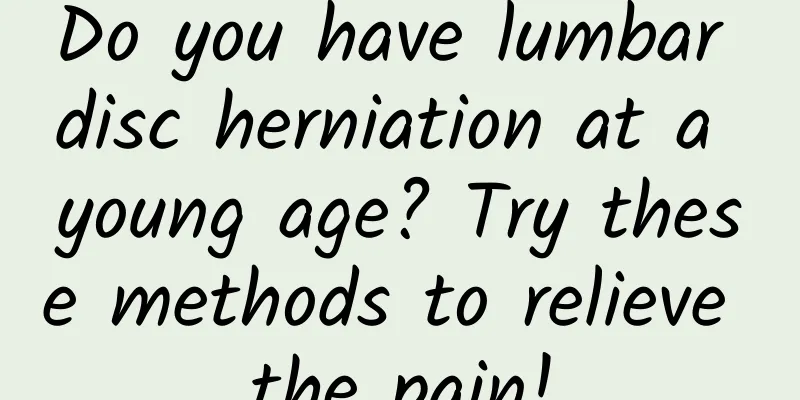Do you have lumbar disc herniation at a young age? Try these methods to relieve the pain!

|
I don’t know if you have noticed that when the weather turns cooler, there are always many articles about the lumbar spine. Some of them will also give detailed data, such as how much force is applied to the lumbar spine when standing and how much force is applied to the lumbar spine when sitting... Online rumor source: Weibo How strange! People are different in height, weight, and size, so how can the force on the lumbar spine be the same? Furthermore, what is the relationship between the lumbar spine and the seasons? To answer these questions, we need to first understand the lumbar spine. What exactly are we talking about when we talk about the lumbar spine? When talking about back pain, many people will subconsciously touch the lower back. In fact, what you can touch on the lower back is a part of the lumbar spine, called the spinous process; and the "lower back pain" people talk about is usually related to lumbar disc herniation. The intervertebral disc is a bit like the air pressure rod on the office chair. The upper and lower ends are connected to the cartilage on the vertebral body; the surrounding is a circle of fibrous tissue, which plays a role of restriction and protection; in the middle is the gelatinous nucleus pulposus, which is responsible for bearing and dispersing pressure. Intervertebral disc diagram source: commons.wikimedia.org However, the intervertebral disc is much more powerful than the pneumatic rod. Generally speaking, the load-bearing limit of an office chair is around 150 kg; the limit of the nucleus pulposus is around 300 kg. On the other hand, the nucleus pulposus has the ability to dynamically adapt. When the spine is under pressure, it discharges water and disperses the pressure to the lower vertebrae and surrounding ligaments and muscles; after the pressure disappears, the nucleus pulposus absorbs water from all around to maintain the normal shape of the spine. It is precisely because of this adaptation that we can carry out various activities. Why does a disc herniate? Office chairs often have various deficiencies due to their design and materials; if you don’t take good care of them when using them, they will break down faster. The same is true for intervertebral discs, which have imperfections and need attention. First, the nucleus pulposus of the lumbar spine is not in the middle of the intervertebral disc, but slightly to the back, and the surrounding annulus fibrosus and ligaments are also strong in the front and weak in the back. For example, if the hole of an air pump is slightly to the back, then when the chair tilts forward, its back wall may crack. Second, the pressure-bearing capacity of the nucleus pulposus is closely related to its water content, which is related to age. The water content of the nucleus pulposus of infants is about 90%, but by the age of 30, it is only 70%, and then remains stable until old age. 30 years old is often the time when a person needs to do the most physical work, and the lumbar disc will become weak at this time. This is why lumbar disc herniation often occurs in young and middle-aged men. Third, for women, during pregnancy, a series of changes will occur throughout the body to accommodate the arrival of a new life. For example, the ligament system becomes loose, but the force on the waist increases, making it easy to encounter intervertebral disc problems. Fourth, it is the stress on the waist during daily activities. Source of spinal forces in different postures: Reference 8 Of course, this result is not without controversy. Some recent studies have shown that the pressure on the intervertebral discs is less in a relaxed sitting position than in a standing position. However, one thing is recognized: sitting forward, that is, the position of working at a desk, is more prone to intervertebral disc damage. Is it definitely the intervertebral disc that is to blame for lower back pain? At this point, some readers will definitely ask: Does lower back pain mean a herniated disc? Not really. In fact, back pain can be said to be the most common physical problem. Foreign studies show that 53% of light manual laborers and 64% of heavy manual laborers have experienced back pain. The "Healthy China Action (2019-2030)" pointed out that in 2017, there were 776 million employed people in my country. Based on this estimate, at least 400 million people have experienced back pain. These pains may be related to the intervertebral disc or may be caused by other tissue damage. Therefore, if you encounter back pain, you should go to the hospital for a check-up as soon as possible. Past physical condition, physical examination, as well as X-ray, CT, and MRI all have certain diagnostic value. Causes of back pain Source: Self-made by the author Once you are diagnosed with lumbar disc herniation, you should be careful. If the air pump of the chair is broken, you can just replace it with a new one; there are cone holes on the side of the intervertebral disc, and nerves are hidden inside. If left untreated, the intervertebral disc will compress the nerves, which may cause numbness of the lower limbs and sciatica; in the most serious cases, it will lead to decreased sensation and incontinence. If I have lower back pain, do I need to stay in bed and rest? no. Here we have to go back to the nucleus pulposus. There are almost no blood vessels in the nucleus pulposus, and the nutrients needed by the intervertebral disc are diffused from the surrounding fluid. To be more specific, the nucleus pulposus is like a small water pump. When the spine is compressed, it discharges old fluid; when the pressure is relieved, it draws in fresh, nutrient-rich fluid. Therefore, long-term bed rest is actually not conducive to the recovery of intervertebral discs. Risk factors for disc herniation Source: Author's own Depending on the morphology of intervertebral disc herniation, this disease can be divided into 5 categories. Among them, the most common is the bulging type, where the annulus fibrosus is partially ruptured, but the surface is still intact; the nucleus pulposus compresses the nerves, but overall it is not serious. Moreover, as time goes by, the nucleus pulposus will slowly shrink and become smaller after leaving its physiological position, and the pressure on the nerves will be reduced accordingly. Therefore, this situation generally does not require surgery, only conservative treatment; and the treatment effect is not bad, with an 80% to 90% success rate. There are many conservative treatment methods, such as medication, injections, traction, massage, acupuncture, etc., all of which have certain effects. You can discuss a suitable plan with your doctor according to your own situation. There is nothing to be afraid of surgical treatment. Just choose a regular hospital and understand the surgical indications and risks in advance. In addition, there are some new treatments in recent years. In time, lumbar disc herniation may no longer be a problem. So, how to prevent lumbar disc herniation? This problem can be divided into two situations. For people who already have the disease, the focus is on preventing a relapse. Many patients, because of the sudden onset of the disease and unbearable pain, complain that they do not pay attention to exercise on a daily basis and want to exercise immediately. In fact, although exercise can help prevent recurrence, experts recommend not to start immediately - wait until the condition stabilizes, and then talk about it after two or three weeks. When exercising, you should also pay attention to choosing activities that are more friendly to the spine, such as swimming, walking, and Tai Chi. Traditionally, it is believed that a hard bed is best for the lumbar spine. However, a European study in 2003 showed that a medium-hard mattress is the first choice. If the pain is severe, you can consider lying on your back and putting a cushion under your legs to disperse some of the pressure on the intervertebral disc. As for waist protection, ergonomically designed waist pads and seat cushions can be used according to your own situation. How to protect your waist Source: Made by the author For most people, the most important thing is to avoid sitting for long periods of time. Get up and move around every two hours. This is not only good for your waist, but also for your whole body. Research by Chinese scholars shows that people who sit for six consecutive hours have a greater risk of heart disease and diabetes. Conclusion Having said that, let’s look back at how to answer the question at the beginning? Question 1: Why should we keep warm? Answer: Because there are less muscles and fat behind the lumbar spine, it is easily affected by low temperatures. Severe cold may cause lumbar joint stiffness and nerve root edema. Question 2: Is the statement in the opening picture correct? Answer: Incorrect. The amount of force on the lumbar spine varies from person to person; for the same person, sitting at a desk is more "tough on the waist" than standing naturally. References [1] Li Ming, He Da (eds.). Lumbar Disc Herniation 3rd Edition [M/OL]. China Medical Science and Technology Press, 2021 [2022-10-23]. http://book.ucdrs.superlib.net/views/specific/2929/bookDetail.jsp?dxNumber=000030482208&d=D2444FABB8615F93C0ADC3A3C9034C06&fenlei=1609100105. [2] Zhou Mouwang, Yue Shouwei, He Chengqi. “Rehabilitation treatment of lumbar disc herniation” Chinese expert consensus[J]. Chinese Journal of Rehabilitation Medicine, 2017, 32(02): 129-135. [3] Spine Surgery Group of the Chinese Orthopaedic Society, Orthopaedic Rehabilitation Group of the Chinese Orthopaedic Society. Guidelines for the diagnosis and treatment of lumbar disc herniation[J]. Chinese Journal of Orthopaedics, 2020(08): 477-487. [4] Wang Xiangrui, Feng Zhiying, Zhang Xiaomei. Chinese pain expert consensus on the diagnosis and treatment of lumbar disc herniation[J]. Chinese Journal of Pain Medicine, 2020, 26(01): 2-6. [5] CAO Z, XU C, ZHANG P, et al. Associations of sedentary time and physical activity with adverse health conditions: Outcome-wide analyzes using isotemporal substitution model[J/OL]. eClinicalMedicine, 2022,48[2022-10-23]. https://www.thelancet.com/journals/eclinm/article/PIIS2589-5370(22)00154-7/fulltext. DOI:10.1016/j.eclinm.2022.101424. [6] EISENSTEIN SM, BALAIN B, ROBERTS S. Current Treatment Options for Intervertebral Disc Pathologies[J/OL]. Cartilage, 2020, 11(2): 143-151. DOI:10.1177/1947603520907665. [7] ALAMIN TF, AGARWAL V, ZAGEL A, et al. The effect of standing vs. variants of the seated position on lumbar intersegmental angulation and spacing: a radiographic study of 20 asymptomatic subjects[J/OL]. Journal of SpineSurgery,2018,4(3):509-515. DOI:10.21037/jss.2018.08.03. [8] NACHEMSON A. Towards a better understanding of low-back pain: a review of the mechanics of the lumbar disc[J/OL]. Rheumatology and Rehabilitation,1975,14(3):129-143.DOI:10.1093/rheumatology/14.3.129. END Author: Zhao Yanchang, science writer Editor: Guru |
>>: Should you gain weight in autumn? Here are some tips on keeping fit in autumn
Recommend
Will there be pimples outside the vagina if there is inflammation?
Vaginitis is a common gynecological disease among...
Why do I have abdominal pain during ovulation?
Women's body structure is quite special, and ...
Why is there an allergic reaction to cucumber facial application?
Cucumber is a delicious vegetable. It was introdu...
How much harm does abortion do to the body?
Every woman needs to try to realize the great har...
How big is a woman's belly when she is eight months pregnant?
I believe many people will ask: How big will a mo...
Is intermittent fasting good or bad for weight loss?
Cai Jiaqing, School of Basic Medical Sciences, Hu...
What are the dangers of pulling out armpit hair? Can it cause body odor?
Many women frequently pluck their armpit hair in ...
What should a woman do if she has hemorrhoids?
Although women are generally described with words...
What is irregular endometrial hyperplasia
Girls are born great. They suffer from many gynec...
【Health Lecture】What is senile pruritus
In order to ensure the popularization effect of l...
29 weeks pregnant stomach pain
Abdominal pain at 29 weeks of pregnancy is an abn...
What should women do if they have insomnia and dream a lot at night?
Insomnia is a very scary thing for us. Once peopl...
Frequent uterine contractions
Nowadays, many women suffer from gynecological di...
Normal weight and height for girls aged 13
What is the normal height and weight of a 13-year...
What can I eat to relieve nausea and vomiting during early pregnancy?
Many young pregnant women experience dizziness, n...









